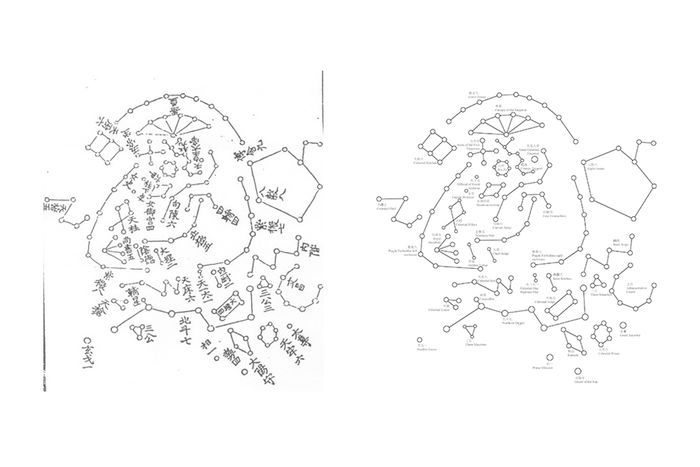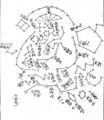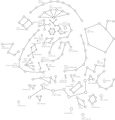(Translation) 天文類秒
| Primary Source | ||
|---|---|---|
 |
Title | |
| English | An Introduction to Astronomy | |
| Chinese | 天文類秒 | |
| Korean(RR) | 천문류초(Cheonmun Ryucho) | |
| Text Details | ||
| Genre | Old Books(古書) | |
| Type | Introduction | |
| Author(s) | 李純之 | |
| Year | 朝鮮 世宗 朝 | |
| Source | ||
| Key Concepts | Constellation, Astronomical and Weather Phenomena | |
| Translation Info | ||
| Translator(s) | Sotirova Irina Vladimirova (Participants of 2017 Summer Hanmun Workshop (Advanced Translation Group)) | |
| Editor(s) | Sotirova Irina Vladimirova | |
| Year | 2017 | |
Introduction
Central Part of the Sky Map Based on 15th century Korean Astronomy Book Cheonmun Ryucho (Design of the translated version of the map by Irina Sotirova)
The interest in the sky and the sky luminaries in Korea dates back to the Three Kingdoms era (1st to 7th century AD). Serious research, however, began during the Joseon dynasty (1392 – 1897). During the reign of King Sejong (r. 1418 – 1450) astronomer Yi Sun-ji (李純之 | 이순지; 1406 – 1465) wrote a book in two volumes, named Cheonmun Ryucho (天文類秒 | 천문류초), explaining the constellations and the various cosmic phenomena. Part of the book is this map of the central part of the sky, representing 164 stars grouped in 36 constellations.
Chinese and Korean star charts strike one with their geometric patterns, as if drawn by an urban architect. In them we can see the city walls and the imperial palace with all the facilities, including the kitchens, guardhouses, even the prison. Many of the buildings are identified with their inhabitants – ministers, judges, military, maids-in-waiting and servants. It is interesting to note that a number of constellations comprise a single star. Sky maps copied land topography and state structures onto the sky. Chinese and Korean astronomers find isomorphism between the stars and constellations in the sky, and the administrative institutions and city buildings on earth. Traditionally, the sky on Chinese and Korean star charts is divided into five parts: one central and four peripheral corresponding to the four cardinal directions. The central part of the map is the most important, as it depicts the Imperial Palace. In the left and right part of the circle there are two arcs resembling hand palms. These are the Purple Forbidden left enclosure with 8 stars (紫微八 | 자미팔) and the Purple Forbidden right enclosure with 7 stars (紫微七 | 자미칠). In the middle between the two walls is an arc comprising 5 stars – this is the North Polar constellation (北極五 | 북극오). The North Polar constellation is the residence of the Imperial family. The ones who live in it are [from left to right] the Crown Prince (太子 | 태자), the Emperor (帝 | 제), the Son of a concubine (庶子 | 서자), the Concubine (後宮 | 후궁) and the Celestial Pivot (天樞 | 천추). The Celestial Pivot is surrounded by four other stars called the Four Counsellors (四輔四 | 사보사).
The most important star in the sky is Polaris (North Polar star), which corresponds to a hypothetical “eternal” central star. Polaris is in the centre of the chart and the whole Cosmos revolves around it. If we project the Cosmos back on Earth, quite logically the Earthly Emperor becomes the centre of the world around whom everything earthly revolves. This role is postulated by Confucius as follows: "He who exercises government by means of his virtue may be compared to the north polar star, which keeps its place and all the stars turn towards it." (Analects of Confucius, 2-1; translation by James Legge). However, the earth’s spin axis is not constantly directed towards one and the same point on the sky and within a period of about 26 000 years, it makes a small circle. That is why 4000 years and even longer ago, since astronomical observations began, the role of the North Polar star has not been played by α of Ursa Minor – the last one in its tail, which we all know today. In different periods, the North Polar stars were different, for example The Emperor (帝 | 제; 2nd star of Northern Pole), The Supreme one (太一 | 태일) or the Great Celestial Emperor (天皇大帝 | 천황대제). There have been times, lasting a millennium, when there was not a star bright enough positioned in the very centre of the sky and that is why some of the nearest ones were used.
At the bottom of the disk are the Seven Stars of the the Northern Dipper (Big Dipper or Ursa Major), drawn as a dipper or a car with an open quadrangle. The Seven Stars refer to Sun, Moon, and the five major planets Mercury, Mars, Jupiter, Venus and Saturn. The Northern Dipper is highly worshiped in Taoism and it is believed that it determines the length of the human life and is responsible for removing names from the records of death.
The presented central part of the sky contains the constellations visible at any time of the year. It is, however, just one part of whole planisphere, divided to central and four peripheral parts according to the four directions. These peripheral parts form four unequal quadrants, the east, north, west and south, respectively protected by dragon, tortoise, tiger and bird. The four quadrants correspond to the four seasons – east part is visible on spring, south part is visible on summer, west part on autumn and north part on winter. The constellations depicted on the central part of the chart and on the periphery are an integral part of the religion, philosophy, mythology and folk beliefs in Korea.
Original Script
- Alphabetical Order
| No. | Classical Chinese | English |
|---|---|---|
| 1 | 文昌 | Administrative Center |
| 2 | 華蓋 | Canopy of the Emperor |
| 3 | 杠九 | Canopy Support |
| 4 | 天床六 | Celestial Bed |
| 5 | 天棓五 | Celestial Flail |
| 6 | 天理四 | Celestial Judge |
| 7 | 天廚六 | Celestial Kitchen |
| 8 | 天槍 | Celestial Lance |
| 9 | 天一太一 | Celestial One Supreme One |
| 10 | 天柱 | Celestial Pillars |
| 11 | 天牢六 | Celestial Prison |
| 12 | 大理二 | Chief Judge |
| 13 | 輔星 | Counsellor |
| 14 | 句陳六 | Curved Array |
| 15 | 八穀八 | Eight Grains |
| 16 | 勢四 | Eunuch |
| 17 | 女史 | Female Protocol |
| 18 | 四輔四 | Four Counsellors |
| 19 | 太尊 | Great Ancestor |
| 20 | 天皇大帝 | Great Celestial Emperor |
| 21 | 太陽守 | Guard of the Sun |
| 22 | 傳舍九 | Guest House |
| 23 | 陰德 | Hidden Virtue |
| 24 | 内厨二 | Inner Kitchen |
| 25 | 内階 | Inner Steps |
| 26 | 女御官四 | Maids-in-waiting |
| 27 | 北斗七 | Northern Dipper |
| 28 | 北極五 | Northern Pole |
| 29 | 柱下史 | Official of Royal Archives |
| 30 | 相一 | Prime Minister |
| 31 | 紫微八 | Purple Forbidden left enclosure |
| 32 | 紫微七 | Purple Forbidden right enclosure |
| 33 | 尙書五 | Royal Secretary |
| 34 | 五帝坐 | Seats of the Five Emperors |
| 35 | 六甲 | Six Jia |
| 36 | 三公(2回) | Three Ministers |
| 37 | 玄戈一 | Sombre Lance |
- Discussion Questions:
Further Readings
- To view the full texts, click the links below.
- View together with '星鏡(Sŏnggyŏng, A mirror reflecting the stars)'

